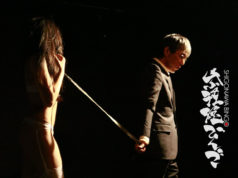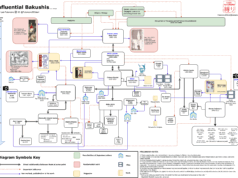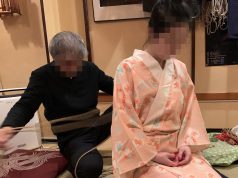First off, congratulations on the release and nice reception for the “Come Unwound” video (now available for viewing on YouTube) as well as the great review in the LA Weekly.
Thank you. However, the credit should go to Anna Bulbrook and Mark Sallis of The Bulls and the video’s director Evan Mathis. They did all the important work. We (the LA Rope Dojo) were only part of the design of the video.
How did you and the LA Rope Dojo get involved in the project?
We were approached by director Evan Mathis who was aware of some of the other media work we had done and were asked to take a meeting about his conception for the video for this new song that was going to be recorded. We met and I was immediately impressed by both Evan’s visual ideas and his non exploitative use of Kinbaku.
What do you mean?
Well, it’s no surprise that Kinbaku often gets used in an erotic context. However, the song that the video was dramatizing is all about the poignant break up of a relationship and of loss. Therefore, there was a metaphoric use of Kinbaku that was a little different and quite sophisticated as well as the sensual side that was visualized.
There is a lot of tying in the video. How many Kinbaku ties did you do?
We did five different ties including a fairly difficult reverse Gyaku-ebi suspension. It was important that the ties have a very designed look to fit in with the concept for the video and this was the interesting rigging challenge in this project.
How did the shoot go?
Very well. Fortunately, my friend and student Zetsu was available to expertly assist (and take the excellent photographs that illustrate this interview) and we were blessed with having a very good model (beautifully abused on fetlife). In addition to that, Evan was one of the most organized directors I’ve had the pleasure to work with. Everything came off like clockwork. His crew was very professional and did their work well and when he said we would we be done in three hours he meant it. Quite often on these projects there is a sense of disorganization because the producers aren’t that familiar with Kinbaku and what it involves but that wasn’t the case here.
Has the LA Rope Dojo done many media projects?
Yes. In just the last few months we did a project with the English performance artist Millie Brown which will be coming out as an Internet program next year and we also did some work on a book that is tentatively entitled “Fifty shades of Yoga.”
Do you enjoy doing these projects?
Very much. Whenever it’s possible to show the artistic side of the Kinbaku it’s an opportunity that shouldn’t be missed. As I’m sure you can understand, it’s a great thrill to have the word Kinbaku used seriously as an artistic term on the front page of the LA Weekly. Even though the Weekly is a very “hip” newspaper that still wouldn’t have happened 15 years ago.
Are there a lot of differences between tying for media and tying for a BDSM session?
Yes, there are many. When I tie in a private session it’s for the satisfaction of my model/partner as well as my own artistic expression and satisfaction. When I’m doing a media project my responsibility is to the audience and to the director. On top of that, because of the time it takes to film these projects, one has to be very aware of the model safety and stamina.
Where did you learn to do this type of rigging?
Well, I was very fortunate in that one of my sensei is the remarkable Urado Hiroshi who is perhaps the greatest film rigger of all time. He did all of the famous Nikkatsu SM movies in the 1970s and 80s. For instance, he did the first “Flower and Snake” film and also “Wife to be Sacrificed” both starring the legendary actress Naomi Tani. I learned a great deal from studying and talking with him and I’ve put every bit of it to use.
Thank you for taking the time to talk to us and congratulations again on your work and the success of the video.






